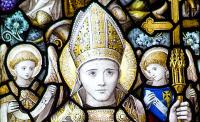
Feast day: 26 May
Christianity had been established Britain by the Romans, but when they left in 431 pagan tribes took their place in the south and east, and much of the Christian heritage disappeared. It was against this background that Pope Gregory I decided to send a mission to convert the Anglo-Saxons. The Kingdom of Kent was ruled by King Ethelbert, who had married a Christian princess called Bertha. She was the daughter of Charibert, one of the Merovingian kings of the Franks, and her husband - though still a pagan - allowed her freedom of worship. It is possible that Bertha asked Pope Gregory to send a mission to England. On the other hand, the initiative may very well have come from the latter. St Bede, in the eighth century, told the well-known story where the Pope saw the fair haired Saxon slaves in the market and was inspired to bring Christianity to their people. Since Kent was the dominant power in south-eastern England it was the obvious place to begin the mission.
In 595, Gregory chose Augustine, who was prior of St Andrew in Rome, to go to Kent. He selected monks to accompany Augustine and sought support from the Frankish royalty and clergy in a series of letters, some of which still survive in Rome. The Frankish bishops and kings provided interpreters and priests to accompany the party. The connection with the Franks helped to secure to a friendly reception from King Ethelbert, whose wife was one of them. King Chlothar of Neustria, who had aided Augustine, was glad of a chance to establish good relations in Kent to protect himself against his fellow Frankish kings. It is not clear why Gregory chose a monk to lead the mission but he once wrote to King Ethelbert praising Augustine’s knowledge of the bible, so he was obviously well educated. He was also a prior, which meant that he had experience in administration.
Augustine was accompanied by Laurence of Canterbury, who would succeed him in the Archbishopric, and forty companions, some of whom were monks. Soon after leaving Rome they sent Augustine back to the Pope to request his permission to return, since they were afraid of the task ahead of them. Gregory refused and sent letters urging the missionaries to persevere. They settled in Kent and were allowed to preach in Ethelbert’s capital Canterbury, where they used the church of St Martin for their services. The King was converted, probably in 597, as the ruler’s example would encourage mass conversions and it is evident that Augustine had accomplished these within a year of his landing. Also by 601 Gregory was writing to both Ethelbert and Bertha, calling the king his son and referring to his baptism.
Augustine established his episcopal see at Canterbury. It is not known when exactly he became bishop. Soon after his arrival he founded the monastery of Ss Peter and Paul, which later became St Augustine’s Abbey. He sent Laurence back to Rome to report on his progress and to ask Gregory’s advice on church organisation and discipline.
Further missionaries were sent to Britain from Rome in 601. They brought a pallium for Augustine, a symbol of metropolitan status, which signified that Augustine was now an archbishop, confirmed by the Holy See. They also brought a present of sacred vessels, vestments, relics and books. The archbishop was directed by Gregory to consecrate twelve suffragan bishops and to send a bishop to York. He intended to have two metropolitans one in London and one in York with twelve suffragans under each. Canterbury was established after the death of Ethelbert as the principal see. Two of Augustine’s companions were consecrated as Bishops of London and Rochester.
Bede relates that Augustine, with the help of the king, “recovered” a church, built by Roman Christians in Canterbury and probably previously used for pagan worship. In 1973 the remains of an aisled building were uncovered, just south of the present Canterbury Cathedral. Augustine probably had contacts with native Christians. He failed to extend his authority over Wales and the west. Gregory wanted these Christians to submit to Augustine. At a meeting with their bishops, Augustine refused to rise when they entered and they refused to recognise him as their archbishop. There were already deep differences preventing agreement, such as the tonsure, the observance of Easter and other practical differences as regards asceticism, missionary activity and church organisation. It has been suggested that Augustine had no real understanding of the British or Celtic church. There were also political dimensions since Britain was divided into several kingdoms. The dispute between the Celtic and Roman church was finally settled at the Synod of Whitby in 664. Before his death in 604, Augustine had consecrated Laurence as his successor.
Augustine was originally buried in the portico of what is now St Augustine’s, Canterbury, but was later exhumed and placed in a tomb in the abbey church, which became a place of pilgrimage. After the Norman conquest, the cult of St Augustine was actively promoted. King Henry I granted St Augustine’s Abbey a six-day fair around the date on which Augustine’s relics were translated to his new shrine.
A life of Augustine was written by Goscelin in 1090, but it differs from Bede’s. It has little historical content and is mostly a hagiography. Other hagiographies followed, adding new miracles and stories to Augustine’s life. Many documents failed to distinguish between St Augustine of Hippo and St Augustine of Canterbury. Bede is probably the most reliable source and he wrote in 731, much nearer in time than Goscelin.
During the Reformation, Augustine’s shrine was destroyed and his relics were lost. The shrine was re-established on 2012 at the church of St Augustine, Ramsgate, Kent, very close to where the missionary landed. St Augustine’s Cross, a Celtic cross erected in 1884, marks the spot very close to the mission’s landing site.
St Augustine of Canterbury, pray for us.